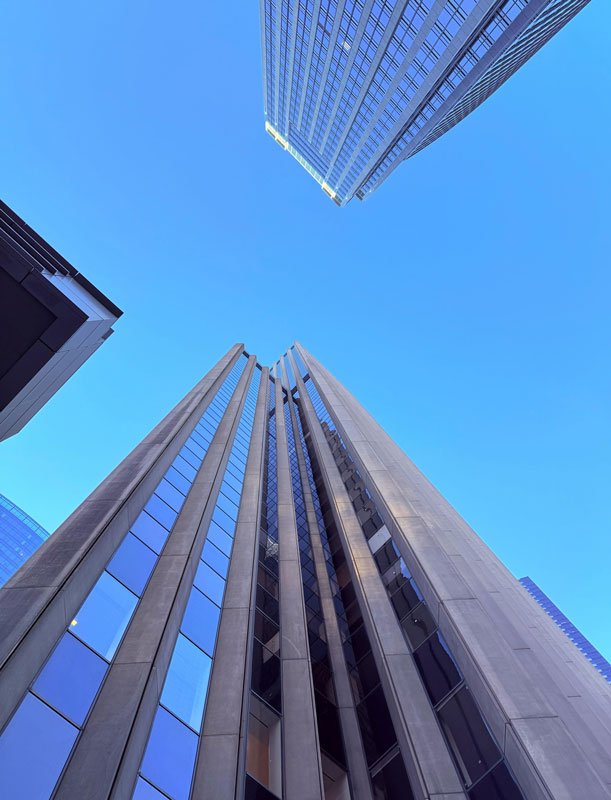Understanding Different Types of Commercial Glass Used in High-Rise Construction

When we look at the gleaming facades of modern skyscrapers, what we often admire is the expansive glasswork. Well, the choice of glass in high-rise construction is not just about appearance; it’s a critical engineering decision shaped by factors like climate, safety, energy use, and cost. For that reason, understanding the different high-rise building glass types is key for architects, developers, and engineers who aim to balance form and function. Let’s decode it.
The Role of Glass in High-Rise Architecture
Before exploring the types, it’s worth understanding why glass plays such a dominant role in modern high-rises.
Compared to traditional low-rise buildings, skyscrapers face unique structural challenges. To name a few, they struggle with wind pressure, temperature shifts, and intense sun exposure. Hence, glass, when engineered correctly, can combat these challenges. It also allows natural light to penetrate deep into the building, reducing the need for artificial lighting.
This is why the selection of specific high-rise building glass types becomes essential. Different buildings require different glazing solutions based on purpose and local environmental factors.
Starting with the Basics: Annealed vs. Tempered Glass
All commercial glass starts as annealed glass, which means a basic, untreated form. Since annealed glass is brittle and shatters into sharp pieces, this is unsuitable for high-rises. So, to improve strength and safety, it undergoes thermal treatment to become tempered glass, which is up to four times stronger and crumbles into small and blunt fragments when broken.
Tempered glass is the baseline safety standard, and it’s frequently used in windows and facades where breakage might endanger pedestrians below. However, it’s only the first step toward safety glass options for skyscrapers.
Laminated and Insulated Glass
As we move beyond basic strength, laminated glass comes into focus. To understand that, imagine a glass sandwich — two panes bonded with a plastic interlayer. What makes this glass different is its ability to hold together even if shattered, which reduces fall risk. For that reason, laminated glass is particularly useful in storm-prone or seismic regions.
Then, we have another type, Insulated Glass Units (IGUs). This type of glass takes it further by combining two or more panes with a vacuum or gas-filled space in between, which drastically improves thermal efficiency. These energy-efficient commercial glazing solutions reduce the need for heating and cooling, contributing to LEED certification and long-term operational savings.
Now, let’s compare all of the glass types at a glance.
| Glass Type | Safety Rating | Energy Efficiency | Common Use in High-Rises | Best-Suited Climate | Relative Cost | |
| Tempered Glass | Medium | Low | Windows, facades |
|
Low ($5 to $35 per square foot) | |
| Laminated Glass | High | Moderate | Safety-critical areas | Seismic, hurricane, urban zones | Medium ($10 to $40 per square foot) | |
| Insulated Glass | Moderate | High | Curtain walls, external glazing | Hot, cold, and variable climates | High ($20 to $40 per square foot) |
High Performance and Aesthetic Flexibility: Low-E and Reflective Glass
Once basic safety and insulation are covered, design considerations come into play. Low-emissivity (Low-E) coatings are applied to glass to reflect infrared light while allowing visible light through. This fine-tuned balance helps maintain indoor temperature and reduces glare, making it a top-tier energy-efficient commercial glazing solution.
Similarly, reflective glass features a metallic coating that mirrors sunlight. This reduces solar heat gain and adds privacy. In cities with dense populations and strict energy codes, these types of glazing aren’t just optional; they’re often required.
Choosing the Right Mix for Every Project
Every skyscraper tells a story, and the glass it wears is a critical part of that narrative. The right combination of high-rise building glass types depends on the building’s location, purpose, and desired performance. For instance, a commercial office tower in Dubai might prioritize reflective and insulated glass, while a residential high-rise in Tokyo might lean toward laminated glass for earthquake resilience.
In the end, safety glass options for skyscrapers are not one-size-fits-all. They’re a toolkit of advanced materials engineered to meet the demands of vertical living. It’s much like choosing the right armor for a knight. Some pieces protect against fire, and others protect against arrows. Just like that, each type of glass plays a specific role in shielding and enhancing a building.
Partnering with the Right Experts Makes All the Difference
While choosing the right type of glass is crucial, finding the right professionals to install it is just as important, because even the highest-performing glazing systems can underdeliver if not installed with precision and care.
If you’re looking for the right crew to match your glass, Glazier Consulting bridges the gap between top-tier materials and expert installation. Whether you’re building up or scaling fast, we’ll connect you with glaziers who fit your project, your budget, and your standards seamlessly. Start with Glazier Consulting today. Serving all 50 states!